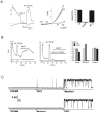Phosphoinositide regulation of TRP channels
- PMID: 24961984
- PMCID: PMC4527175
- DOI: 10.1007/978-3-319-05161-1_18
Phosphoinositide regulation of TRP channels
Abstract
Transient Receptor Potential (TRP) channels are activated by stimuli as diverse as heat, cold, noxious chemicals, mechanical forces, hormones, neurotransmitters, spices, and voltage. Besides their presumably similar general architecture, probably the only common factor regulating them is phosphoinositides. The regulation of TRP channels by phosphoinositides is complex. There are a large number of TRP channels where phosphatidylinositol 4,5 bisphosphate [PI(4,5)P2 or PIP2] acts as a positive cofactor, similarly to many other ion channels. In several cases, however, PI(4,5)P2 inhibits TRP channel activity, sometimes even concurrently with the activating effect. This chapter will provide a comprehensive overview of the literature on regulation of TRP channels by membrane phosphoinositides.
Figures



References
-
- Baukrowitz T, Schulte U, Oliver D, Herlitze S, Krauter T, Tucker SJ, Ruppersberg JP, Fakler B. PIP2 and PIP as determinants for ATP inhibition of KATP channels. Science. 1998;282:1141–1144. - PubMed
Publication types
MeSH terms
Substances
Grants and funding
LinkOut - more resources
Full Text Sources
Other Literature Sources
Research Materials
Miscellaneous

